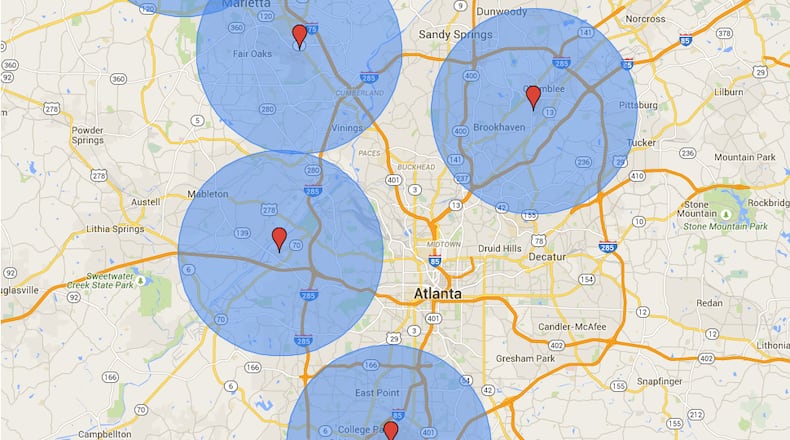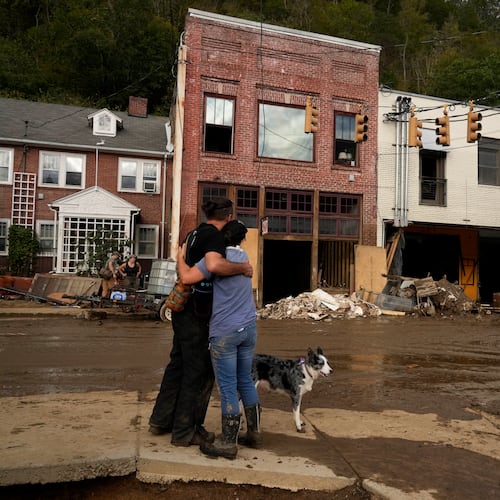In the aviation hub and busy metropolis that is metro Atlanta, there’s often an airplane somewhere overhead.
Now, there are often some drones up there with them.
But many drone owners may be unaware of a federal rule specifying that users of model aircraft — including recreational drones — should not fly within 5 miles of an airport without notifying the airport or its control tower beforehand.
Given the number of smaller airports in the Atlanta region, along with Hartsfield-Jackson International, that covers a sizable chunk of airspace.
The issue has gained national attention as more pilots report drone sightings near airports, including a recent report of a sighting by a Delta pilot landing at New York’s LaGuardia airport and sightings near Newark’s airport.
U.S. Sen. Dianne Feinstein, D-Calif., in June introduced a Consumer Drone Safety Act that would tighten rules for at least some drones.
“Without common-sense rules, I believe it’s only a matter of time before there’s a tragic accident,” she said.
Pilot reports of unmanned aircraft are up “dramatically,” the Federal Aviation Administration said — 650 so far this year, vs. 238 in all of 2014. The FAA warned that operating drones around airplanes and helicopters is dangerous, and said unauthorized users “may be subject to stiff fines and criminal charges, including possible jail time.”
No recent data is available on pilot sightings in this area, an FAA spokeswoman said. FAA reports last year included four sightings by pilots in Atlanta, including reports from a Delta flight and an AirTran flight and one incident in which several airliners reported an unmanned aircraft near one of Hartsfield-Jackson’s runways.
Businesses that get FAA clearance to operate drones for commercial use agree to keep a certain distance away from airports or heliports. But the concern is that hobbyists who buy drones online or at a store do not need any sort of approval to start using them and may be less aware of airspace restrictions.
“There are probably a number of people not complying with it because they don’t know any better,” said Rich Hanson, spokesman for the Academy of Model Aeronautics. “There may be a few people who know about it and don’t comply with it because they don’t know how to get a hold of an airport or they really don’t think it will be an issue.”
Special rule
Those caught violating the “special rule for model aircraft” passed by Congress in 2012 could be subject to FAA enforcement, according to the agency. The language in the rule does not specify whether it applies to private airports or heliports as well as public-use airports, but there are many private airports, and the FAA advises that drone hobbyists use caution around them as well.
Atlanta Hobby owner Cliff Whitney, whose drone sales are a major segment of his business, said the official rules could be made more specific — to apply the five-mile restriction to towered airports, for example.
Even far from airports, there could be other hazards with helicopters or other aircraft. The FAA recently warned that flying a drone near firefighting aircraft is dangerous for pilots and puts lives at greater risk when the firefighting aircraft are grounded because of a drone nearby.
The FAA said those who endanger manned aircraft or people on the ground with a drone could be fined up to $25,000.
Such hazards have historically been avoided through temporary flight restrictions around wildfires preventing any aircraft from flying in the area other than agencies involved in the firefighting.
But with the recent rise of recreational drones, there are hobbyists in neighborhoods everywhere who may not be looped into FAA notices to pilots.
And new drone owners may not be part of the model aircraft clubs that for decades have shared information on safety standards and sometimes use dedicated RC fields for their remote control aircraft flying.
To get the word out, the FAA has launched a campaign called "Know before you fly" with a website and a mobile app called B4UFLY that gives a status indicator for a particular location and contact information for nearby airports.
Losing control
Some inexperienced recreational users find that they lose control of their drone in wind or other hazards.
Hanson said the Academy of Model Aeronautics tells its members to crash their own model aircraft “if that’s what it takes to avoid collision with a manned aircraft.” He said that’s what it takes “‘to make sure you don’t endanger anyone that’s on board the manned aircraft.”
Whitney said that while a small drone ingested in a commercial airliner’s engine is unlikely to endanger the plane, as a private pilot flying with his family, “I don’t want to run into anything in the air — be it a bird or anything else.”
“These things are powerful tools when used properly… for encouraging kids to learn about electronics and navigation and things,” Whitney said. The problem, he said, is that some people buy drones online or elsewhere without any education on proper use. “It’s more of a ‘Hey, hold my beer, watch this’ crowd,” he said.
The FAA advises recreational drone users that they should not fly near manned aircraft, should not fly beyond line-of-sight, and should not operate for payment or commercial purposes because that would require federal approval. State or local ordinances or laws may also apply, such as restrictions to protect privacy from drones taking video or photos. But it may be difficult to track the full array of local laws, which may also change as the new technology prompts new legislation.
The Academy of Model Aeronautics’ privacy policy advises that recreational drone users should not photograph people without permission in areas where there is an expectation of privacy.
About the Author
Keep Reading
The Latest
Featured


